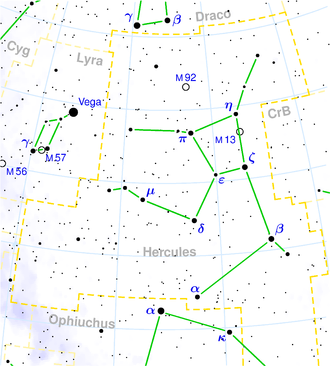NGC 6278
| Galaxy NGC 6278 |
|
|---|---|
![NGC 6278 with NGC 6276 (ro) & SDSS J170047.14 + 230015.1 (ru) [1] SDSS image](https://upload.wikimedia.org/wikipedia/commons/thumb/8/86/NGC6278_-_SDSS_DR14.jpg/300px-NGC6278_-_SDSS_DR14.jpg)
|
|
| NGC 6278 with NGC 6276 (ro) & SDSS J170047.14 + 230015.1 (ru) SDSS image | |
| AladinLite | |
| Constellation | Hercules |
|
Position equinox : J2000.0 , epoch : J2000.0 |
|
| Right ascension | 17 h 00 m 50.327 s |
| declination | + 23 ° 00 ′ 39.70 ″ |
| Appearance | |
| Morphological type | S0 |
| Brightness (visual) | 12.6 mag |
| Brightness (B-band) | 13.6 mag |
| Angular expansion | 2.1 ′ × 1.2 ′ |
| Position angle | 130 ° |
| Surface brightness | 13.5 mag / arcmin² |
| Physical data | |
| Affiliation | WBL 629 NGC 6278 group LGG 409 |
| Redshift | 0.009447 ± 0.000017 |
| Radial velocity | 2832 ± 5 km / s |
|
Stroke distance v rad / H 0 |
(133 ± 9) x 10 6 ly (40.7 ± 2.9) Mpc |
| history | |
| discovery | Wilhelm Herschel |
| Discovery date | May 15, 1784 |
| Catalog names | |
| NGC 6278 • UGC 10656 • PGC 59426 • CGCG 139-029 • MCG + 04-40-011 • 2MASX J17005034 + 2300394 • GC 4266 • H III 124 • GALEX ASC J170050.30 + 230038.1 • HOLM 765A • NSA 147606 • WISEA J170050 .32 + 230039.7 | |
NGC 6278 is a 12.6 likes bright lenticular galaxy of Hubble type S0 in the constellation Hercules at the northern sky . It is estimated to be 133 million light years from the Milky Way and about 80,000 light years in diameter. Together with NGC 6276 , it forms the gravitationally bound galaxy pair Holm 765 and is the brightest member of the small NGC 6278 group ( LGG 409 ).
The object was discovered on May 15, 1784 by Wilhelm Herschel with an 18.7-inch reflector telescope, who described it as “vF, stellar, verified with 240 power”.
NGC 6278 group ( LGG 409 )
| Galaxy | Alternative name | Distance / million ly |
|---|---|---|
| NGC 6267 | PGC 59340 | 133 |
| NGC 6278 | PGC 59426 | 139 |
| PGC 59408 | UGC 10650 | 139 |
